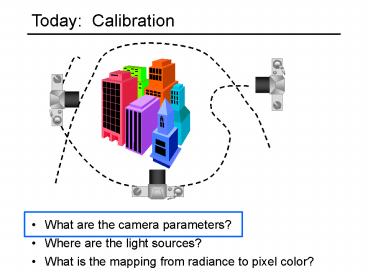Today: Calibration - PowerPoint PPT Presentation
Title:
Today: Calibration
Description:
... [Press 92] Standard technique in photogrammetry, computer vision, computer graphics [Tsai 87] also estimates k1 (freeware _at_ CMU) ... – PowerPoint PPT presentation
Number of Views:129
Avg rating:3.0/5.0
Title: Today: Calibration
1
Today Calibration
- What are the camera parameters?
- What is the mapping from radiance to pixel color?
2
Why Calibrate?
- Want to solve for 3D geometry
- Alternative approach
- Solve for 3D shape without known cameras
- Structure from motion (unknown extrinsics)
- Self calibration (unknown intrinsics
extrinsics) - Why bother pre-calibrating the camera?
- Simplifies the 3D reconstruction problem
- fewer parameters to solve for later on
- Improves accuracy
- Not too hard to do
- Eliminates certain ambiguities (scale of scene)
3
Applications
- 3D Modeling
- Match Move
- Image-Based Rendering
Images courtesy of Brett Allen (Vision for
Graphics, winter 01)
Light field capture and rendering (Levoy
Hanrahan, 96)
4
Camera Parameters
- So far weve talked about
- focal length
- principal (and nodal) point
- radial distortion
- CCD dimensions
- aperture
- There is also
- optical center
- orientation
- digitizer parameters
5
Do we need all this stuff?
- Usually simplify to computable stuff
- Intrinsics
- scale factor (focal length)
- aspect ratio
- principle point
- radial distortion
- Extrinsics
- optical center
- camera orientation
6
Projection Models
- Orthographic
7
The Projection Matrix
Matrix Projection
M can be decomposed into t ? R ? project ? A
projection
intrinsics (A)
orientation
position
8
Goal of Calibration
- Learn mapping from 3D to 2D
- Can take different forms
- Projection matrix
- Camera parameters
- General mapping
9
Calibration Basic Idea
- Place a known object in the scene
- identify correspondence between image and scene
- compute mapping from scene to image
- Problem must know geometry very accurately
- how to get this info?
10
Alternative Multi-plane calibration
Images courtesy Jean-Yves Bouguet, Intel Corp.
- Advantage
- Only requires a plane
- Dont have to know positions/orientations
- Good code available online!
- Zhengyou Zhangs web site http//research.micros
oft.com/zhang/Calib/ - Intels OpenCV library http//www.intel.com/rese
arch/mrl/research/opencv/ - Matlab version by Jean-Yves Bouget
http//www.vision.caltech.edu/bouguetj/calib_doc/i
ndex.html
Disadvantages?
11
Alternative Multi-plane calibration
Images courtesy Jean-Yves Bouguet, Intel Corp.
- Need 3D -gt 2D correspondence
- User provided (lots O clicking)
- User seeded (some clicking)
- Fully automatic?
12
Chromaglyphs
Courtesy of Bruce Culbertson, HP
Labs http//www.hpl.hp.com/personal/Bruce_Culberts
on/ibr98/chromagl.htm
13
Projector Calibration
- A projector is the inverse of a camera
- has the same parameters, light just flows in
reverse - how to figure out where the projector is?
- Basic idea
- first calibrate the camera wrt. projection screen
- now we can compute 3D coords of each projected
point - use standard camera calibration routines to find
projector parameters since we known 3D -gt
projector mapping
14
Calibration Approaches
- Possible approaches (not comprehensive!)
- Experimental design
- planar patterns
- non-planar grids
- Optimization techniques
- direct linear regression
- non-linear optimization
- Cues
- 3D -gt 2D
- vanishing points
- special camera motions
- panorama stitching
- circular camera movement
- Want
- accuracy
- ease of use
- usually a trade-off
15
Properties of Projection
- Preserves
- Lines and conics
- Incidence
- Invariants (cross-ratio)
- can show that the only transformations that
preserve lines and incidence are the projective
transformations - Does not preserve
- Lengths
- Angles
- Parallelism
16
Estimating the Projection Matrix
- Place a known object in the scene
- identify correspondence between image and scene
- compute mapping from scene to image
17
Direct Linear Calibration
18
Direct Linear Calibration
19
Nonlinear estimation
- Feature measurement equations
Minimize image-space error
- How to minimize e(M)?
- Non-linear regression (least squares),
- Popular choice Levenberg-Marquardt Press92
20
Statistical estimation
- Feature measurement equations
21
Camera matrix calibration
- Advantages
- very simple to formulate and solve
- can recover K R t from M using RQ
decomposition Golub VanLoan 96
Disadvantages?
- doesnt model radial distortion
- more unknowns than true degrees of freedom
(sometimes) - need a separate camera matrix for each new view
22
Separate intrinsics / extrinsics
- New feature measurement equations
- Use non-linear minimization
- e.g., Levenberg-Marquardt Press92
- Standard technique in photogrammetry, computer
vision, computer graphics - Tsai 87 also estimates k1 (freeware _at_ CMU)
- http//www.cs.cmu.edu/afs/cs/project/cil/ftp/html/
v-source.html - Zhang 99 estimates k1, k2, easier to use than
Tsai - code available from Zhangs web site and in
Intels OpenCV - http//research.microsoft.com/zhang/Calib/
- http//www.intel.com/research/mrl/research/opencv/
- Matlab version by Jean-Yves Bouget
http//www.vision.caltech.edu/bouguetj/calib_doc/i
ndex.html
i features j images
23
Calibration from (unknown) Planes
- Whats the image of a plane under perspective?
- a homography (3x3 projective transformation)
- preserves lines, incidence, conics
Given 3 homographies, can compute A, R, t
24
Calibration from Planes
- 1. Compute homography Hi for 3 planes
- Doesnt require knowing 3D
- Does require mapping between at least 4 points on
plane and in image (both expressed in 2D plane
coordinates)
- 2. Solve for A, R, t from H1, H2, H3
- 1plane if only f unknown
- 2 planes if (f,uc,vc) unknown
- 3 planes for full K































